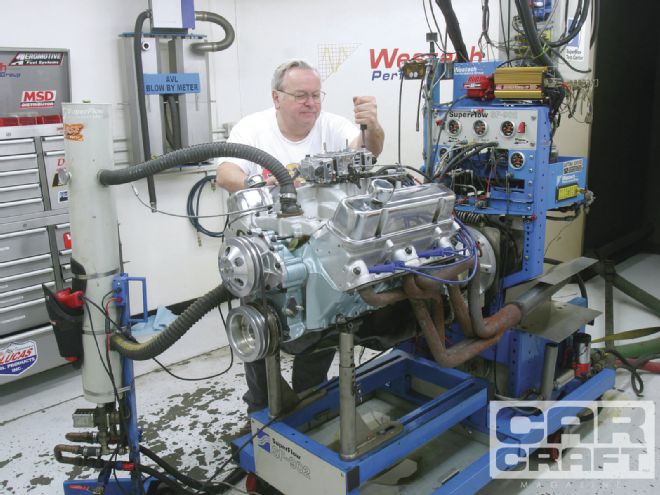
In April 2009, GM officially killed the Pontiac Motor Division. But for true believers of Pontiac engines, GM's Widetrack division is far from deceased. Edelbrock is doing its part by adding to its Pontiac performance parts lineup with Pontiac cylinder heads, something the majority of Pontiac guys have been patiently anticipating. The first Edelbrock Performer RPM aluminum Pontiac cylinder heads, introduced several years ago, were patterned after the high-perf Pontiac Ram Air IV, 455 HO, and Super Duty heads with round exhaust ports. These OE performance Pontiac cylinder heads were highly prized but never built in significant numbers. When Edelbrock replicated these much-sought-after performance heads, the E-Team also retained the RA IV's unique exhaust bolt pattern and round-port configuration. Unfortunately, these ports are not interchangeable with the stock Pontiac D-port exhaust version. This meant you had to find the more rare Super Duty, RA IV, or 455 HO exhaust manifolds or headers to use those Edelbrock Pontiac cylinder heads.
To help make the swap to aluminum heads easier, Edelbrock recently introduced the Performer Pontiac D-Port head that replicates the more popular and traditional Pontiac exhaust port pattern. With the Performer D-Port, the intake port flow is not quite as strong as that on the Performer RPM, but the combustion chamber is now CNC- machined and appears to be superior to the round-port version, which, according to Pontiac engine builder Ken Crocie, required as much as 40 degrees of total timing to make maximum power. Crocie predicted the new chamber could reduce that number, which in our testing proved to be right on target since our test engine required only 36 degrees of total timing. To understand how this works, all you have to do is look at any late-model engine like the Ford mod motor or the GM LS to see how a more efficient combustion chamber uses as little as 25 to 28 degrees instead of much larger timing numbers. If the combustion event takes less time, it requires less ignition timing. This pays horsepower and torque dividends because less timing means less negative work expended by the engine to push the pistons against increasing cylinder pressure before reaching TDC.
Crocie lined up a suitable 455 block to test these new heads but decided it needed enhancement to keep up with the trend of big-cubic-inch street engines. He created a 467ci Pontiac that resulted from the combination of an RPM 4.250-inch stroke crank and a set of Probe 0.065-over 4.185-inch forged pistons. Connecting these two components is a set of Tomahawk I-beam, 6.800-inch rods that can also be found in big-block Chevys, thus keeping the price affordable. Along with a good set of Total Seal Advanced Profiling gapless top rings, this configuration made up the rotating assembly, which was skillfully lubed with a Melling oil pump, a stock oil pan, and a windage tray (that required some minor trimming), all from Pacific Performance. None of this sounds all that aggressive, but combined with a 10.5:1 compression ratio, it's enough to make some pretty serious torque.
Up on the dyno with a set of 1-7/8-inch open headers, it didn't take long after breaking in the Crane flat-tappet camshaft to strike up a deal with the power gods. With 36 degrees of timing and an easy rejet of the Holley 950-cfm carburetor, the Pontiac rewarded Crocie's efforts with 500 lb-ft of torque all the way down at 2,800 rpm and a minimum of 500 lb-ft all the way through 4,800 rpm. Peak torque is 577 lb-ft at 3,600 rpm, which is sneaking up on the 600-lb-ft level. That's amazing power for a normally aspirated street engine on pump gas. Pontiacs are not rpm engines, so it wasn't much of a surprise that peak horsepower occurred at 5,000 rpm. But the power curve didn't really fall off much past the horsepower peak when we spun it to 5,500. This is where the elegance slips in. With an engine like this, you shift it at 5,500 and it will live nearly forever. What's all this grunt worth in terms of quarter-mile performance? We plugged the power into our trusty Quarter Jr. program with a 3,800-pound A-body running a 3.08:1 rear gear, a TH400, a 26-inch-tall tire, and a near-stock 2,600-rpm-stall-speed converter. The program estimated the combo would run 12 teens at 112 mph. With an overdrive automatic, this would be a fantastic road-car engine. So it's clear these Edelbrock heads are far more than just stock replacements, and combined with a decent intake and a very conservative flat-tappet cam, there's plenty of power left in that Pontiac name.